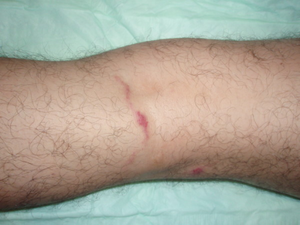We need you! Join our contributor community and become a WikEM editor through our open and transparent promotion process.
Cutaneous larva migrans
From WikEM
(Redirected from Cutaneous Larvae Migrans)
Contents
Background
- Also known as creeping eruption or sandworm disease[1]
- Caused by movement of hookworm (helminth) larvae through epidermis[2]
- Ancylostoma caninum and Ancylostoma braziliense are most common pathogens
- Typically occurs due to contact with dog/cat feces in soil/sand
- More common in warm/tropical areas
- History is typically of a patient sunbathing, walking on the beach, etc in a tropical environment[1]
Clinical Features
- Pruritis serpiginous eruption[2]
Differential Diagnosis
Travel Related Skin Conditions
Papules
- Insect bites
- Scabies
- Seabather's eruption
- Cercarial dermatitis (Swimmer's Itch)
Sub Q Swelling and Nodules
Ulcers
Linear and Migratory Lesions
- Cutaneous Larvae Migrans
- Photodermatitis
Evaluation
- Clinical diagnosis, based on history and physical exam
Management
- Self-limited condition - larvae die within 2-8 weeks[2]
- Goal of treatment is to relieve severe pruritus
- Albendazole 400mg PO QD x3-5 days OR Ivermectin 12mg PO x1 OR topical thiabendazole TID x15 days
- Mebendazole has poor oral bioavailability and does not work for cutaneous larva migrans[3]
Disposition
- Discharge
See Also
References
- ↑ 1.0 1.1 1.2 Vano-Galvan S, Gil-Mosquera M, Truchuelo M, Jaén P. Cutaneous larva migrans: a case report. Cases Journal. 2009;2:112. doi:10.1186/1757-1626-2-112.
- ↑ 2.0 2.1 2.2 Prickett KA, Ferringer TC. What's eating you? Cutaneous larva migrans. Cutis. 2015 Mar;95(3):126-8.
- ↑ 3.0 3.1 Kincaid L, Klowak M, Klowak S, Boggild AK. Management of imported cutaneous larva migrans: A case series and mini-review. Travel Med Infect Dis. 2015 Jul 29.


